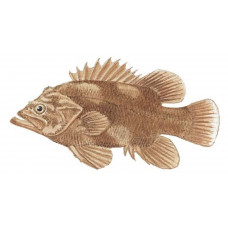Latin name
Polyprion americanus
Other names
Bass, stone bass, wreck bass, hapuku; Afrikaans: wrakvis; Danish: vragfisk; Dutch: wrakbaars; Finnish: hylkyahven; French: chernier commun, mérot gris; Greek: vláchos; Icelandic: rekaldsfiskur; Italian: cherna di fondale; Norwegian and Swedish: vrakfisk; Portuguese: cherne; Spanish: cherna; Turkish: iskorpit hanisi.
Identification
The wreckfish has a deep, strongly compressed body and a very bumpy head with a ridge and bony projections above each eye. Adult fish are uniformly dark brown or bluish gray, while juveniles are mottled. The second dorsal as well as the caudal and anal fins are often fringed in black, although the rounded caudal fin, as well as the pectoral fins, has a white fringe. The dorsal and soft parts of the dorsal fins are serrated, and the lower jaw protrudes beyond the upper jaw.
Distribution
In the western Atlantic Ocean, the wreckfish is found from Newfoundland to North Carolina.
Habitat
Found deep in the continental shelf, at depths of up to 2,000 feet, wreckfish prefer rocky ledges, pinnacles, and ledges around shipwrecks. They are solitary fish and can sometimes be found drifting along with floating wood or other objects.
Size
Wreckfish grow slowly, but can eventually reach 7 feet or more in length and weigh 100 pounds or more. The world record among all tackle is held by a fish weighing 106 pounds, 14 ounces, caught off the coast of Portugal.
Life history and Behavior
No information
Food and feeding habits
Wreckfish feed on crustaceans, mollusks, and deep-sea fish found around shipwrecks or underwater.
Reproduction
No information
| Classification | |
| Phylum | Chordata |
| Class | Actinopterygii |
| Squad | Perciformes |
| Family | Polyprionidae |
| Features | |
| Conservation status | No information |
| Habitat | Bottom |
| Life span, years | 70 |
| Maximum body weight, kg | 99.79 |
| Maximum length, cm | 182.9 |
| Sailing speed, m/s | No information |
| Threat to people | Edible |
| Way of eating | Predator |
Wreckfish
Tags: Wreckfish



